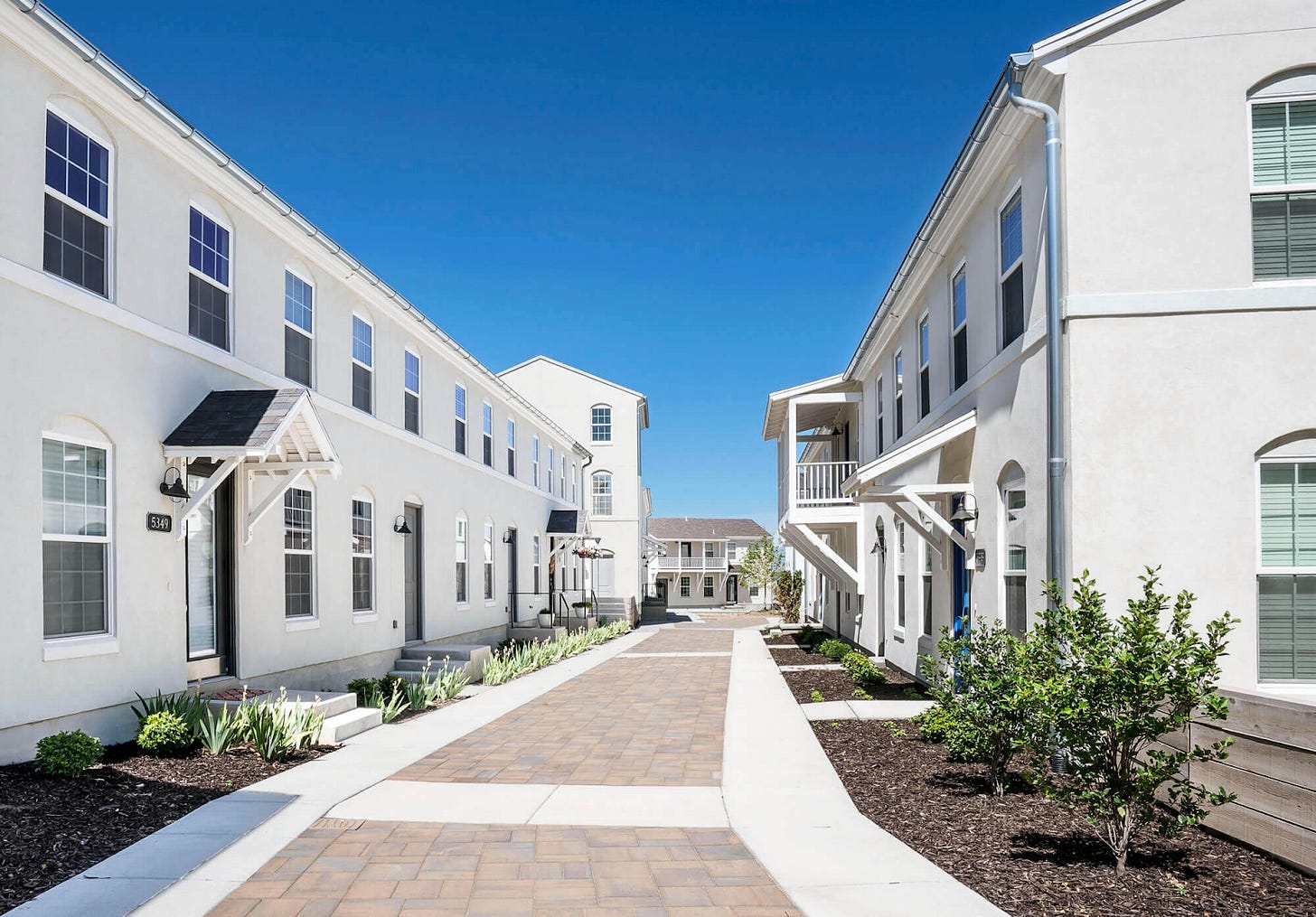3-2-1: A 12-Unit Missing Middle Project, Identifying Structural Issues, 501 Main Updates, & More
Issue #21
Happy Thursday —
Here are 3 things from others, 2 things from me, and 1 picture related to incremental real estate development.
Enjoy!
THREE THINGS FROM OTHERS
I.
If you’re still not sold on Missing Middle Housing, let me introduce you to River House—a 12-unit pocked neighborhood built on less than half an acre in Healdsburg, CA.
Designed by Opticos Design (original architects behind the Missing Middle concept) and JZMK Partners. Developed by Craft Development.
The neighborhood consists of eight single-family homes and four Accessory Dwelling Units (ADUs). On site parking is aggregated at either end of the property.
Amazingly, this project was done as-of-right on one single-family plot. That is, it didn’t require any zoning variances and was already a permitted use in the city’s zoning bylaws. This is a prime example of leading progressive zoning policy by local government.
A couple details resonated with me:
Each home is unique with different layouts, finishes, and styles. Some come with detached ADUs that provide added income for homeowners or an extra place for visitors to stay
The eight homes are for sale (not rental units), allowing for long-term community development
The project emphasizes walkability. Given the site’s central location, residents are only a 15-minute walk from downtown Healdsburg
One downside? Sale prices clock in at $950/SF, or $1.5M+ for the 1,700-SF residences.
This isn’t exactly affordable (or even attainable) housing but neither was it intended to be. We’re talking unsubsidized housing in California, where construction and land costs are well above the national average.
Either way, still a nice piece of Missing Middle eye candy.
Take a look at the promotional video for the project:
II.
Memphis, TN is the latest city to take position as a north star for Missing Middle Housing development.
Last November, the city amended its building code to allow up to six units under the International Residential Code (IRC).
Here are some of the highlights:
Modify the scope and definitions of the IBC and IRC to apply the residential code and all subject provisions to 3- to 6-unit structures
Remove the sprinkler requirement for buildings with 2-hour fire rated walls and floor/ceiling assemblies
Limit public spaces to shared means of egress, but allow upper floor residences to share common egress
No longer require separate mechanical, electrical, and plumbing drawings
Consider how seismic provisions should apply differently to one- and two-family structures versus 3- to 6-unit structures
Presumably, this should make it easier to develop smaller Missing Middle projects. At least from a bureaucratic standpoint.
That said, adoption won’t happen overnight. Developers—particularly those that are established with resources—may be hesitant to pursue the innovative projects incentivized by these zoning changes. Seasoned developers are generally risk-averse, particularly if they were active during previous recessions.
Folks interested in taking advantage of these zoning updates may need to look outside their local markets for examples of Missing Middle housing success stories. Opticos Design’s collection is a great place to start.
III.
It’s encouraging to see local, community-driven action making waves just across the bridge in Lebanon, NH.
A seven-member advisory committee was formed to support the revitalization of the West Lebanon neighborhood—an area that is ripe with opportunity but faces zoning challenges that have prevented several great projects from happening.
A few weeks ago, the committee presented a comprehensive action plan to the city council that delineates a clear path forward. This includes both targeted opportunities for specific parcels of land (abandoned rail yard, greenway development, etc) and reform of certain zoning policies to promote economic development rather than unintentionally discourage it.
The plan was unanimously approved by the city council.
The action plan references 13 studies commissioned by the city since 1997. And, after reading it, the point is abundantly clear—less talk, more walk. It’s time to capitalize on the wealth of information provided in the gamut of completed planning efforts.
What’s amazing is how this was effectively a grassroots movement. The committee is made up of community members who invested weeks (months?) of their own time to create the action plan. Easily a $10,000+ consulting gig if the city had hired an outside firm.
What’s more—having the plan developed by a group of locals that live and breathe the neighborhood ensures a more finely-tuned sense of what is in the best interest of the community at large.
Slide 28 (below) rips the bandaid off and spotlights six proposed projects that were rejected by the city for one reason or another. Many of these projects ultimately went one town over to White River Junction, VT and found resounding success. Soaked in the facts, the slide does a great job illuminating the detrimental effects of current zoning policy while getting specific on constructive feedback.
For more inspiration, check out the West Leb revitalization committee website and their action plan.
TWO THINGS FROM ME
I.
Earlier last year, I made an offer to purchase a single-family foreclosure in Bradford, VT—a 1500 SF, 1825 farmhouse with a massive barn in the village center.
The lender was asking $65,000, I offered $40,000 (here’s the original listing).
The building was in rough condition. It had obviously sat vacant for years and was in dire need of major upgrades—aging plaster walls, outdated kitchens and bathrooms, old roof, missing mechanicals, etc.
However, more glaring were the structural issues. In one area, several joists in the second floor had fractured. In another, a bathroom had leaked to the point the floor and below framing members had completely rotted through.
Most startling though was the basement. Here’s a picture I took of the 1st-floor joists and girder.
This was the worst case of mold I’ve ever seen. In fact, the structure was so rotted in places that you could stick a pencil into the wood with ease. And this wasn’t isolated either—the mold permeated across the entire 500-SF basement.
Long story short, someone else came in at $45,000 and the bank accepted their offer.
I moved on but was always curious what the buyer would do. The new owner was apparently some investor from across the state known for flipping foreclosures.
I completely forgot about it until last week when I got a notification that it was back on the market. This time for $99,900.
Working backwards for a second. With a 6% broker fee, holding costs, closing costs, and a $15,000 profit margin (just a guess), the seller likely only spent $20k-$25k on the renovations.
For that price—and based on the pictures and description of “as-is”—I’m guessing this is a classic lipstick-on-the-pig flip. I have a hard time believing the structural issues were remediated with that low of a budget.
But, it went under contract in only 5 days. Almost expected given the tight housing market.
$99,900 is a lot of money for a building that needs so much work—too much for another investor or developer to pay for it. Hopefully the new homeowner knows what they’re getting into and that either they or their home inspector will find those structural issues.
Another scenario is that the seller didn’t see the structural issues when they purchased and has already blown through their budget trying to remediate before giving up and trying to recoup some of their losses.
Either way, this is a good example of caveat emptor. Don’t forget to do your due diligence no matter how pretty the hardwood floors look inside.
II.
For the past two weeks, I’ve been heads down on 501 Main.
Here’s a quick highlight of what I’ve been up to:
Closed on the construction loan after several delays due to travel and Covid (not me, the attorney). We now have our funding in hand to start the project
Received an incentive package from Efficiency VT that helps offset some of the costs to construct a high performance building. This equates to roughly 2% of project costs
Finalized the septic plan and removed the $12,000 pretreatment system mentioned last week
Conducted the final plan review with the state fire marshal (building inspector) before plan submittal. He requested a few additional items not anticipated, including detailed electrical and plumbing layouts
Solicited plans for the new water supply into the building from a civil engineering firm (another item requested by the fire marshal that we had not anticipated). $800 for a single piece of paper showing a 50’ span of pipe running from the town water main to the building. See below for the link to the plans. This is the sixth engineer I’ve had to hire for the project, but who’s counting?
Received final structural plans from the engineer. I’ll admit, these were daunting at first (check them out in the link below). But after 15 hours pouring through them and several meetings with the engineer, I’m feeling good
Started creating a material takeoff and soliciting final pricing for the framing package. Thankfully, lumber prices have fallen since last summer when I last priced this out (e.g. 30% drop in 2x4 prices) but changes to the plans (addition of front and back balconies, individual heat pumps and hot water heaters per apartment, and a more complex roof by mandate from town) have forced an overall net increase in budget
Curious what the plans are looking like at this point? Here’s the full set of architectural, structural, mechanical, septic, fire suppression, and civil plans. While almost final, there are still a few kinks we’re working through (e.g. handrail and guard design).
Total soft costs so far are around $60,000, or 6% of overall project costs. Additional architecture and engineering effort during construction will be above and beyond that. I’ve baked in some allowance to accommodate oversight and input throughout the construction phase.
ONE PICTURE
I.
The Mews Homes—a 64-unit Missing Middle housing development by Holmes Homes and Opticos Design built in 2019. Price points of homes stayed below $200,000.
📍 South Jordan, Utah
Source: Opticos Design
That’s it for today. Thanks for reading. If you haven’t yet, go ahead and subscribe here:
About me: I’m Jonah Richard, a small-scale real estate developer in Vermont. With my company, Village Ventures, I’m currently getting my hands dirty redeveloping mixed-use buildings along Main Street while trying to pick apart and replicate what makes other communities thrive.
Want to learn more about my projects and incremental real estate development? Connect with me on LinkedIn.







Thanks for sharing your drawings for 501 Main! I live for this stuff.
Re 501 Main and permit process issues: years ago I led a team where developers could come to City Hall and meet with rep from all parties to permit process (fire, B&I, zoning. etc) and share plans for development. City reps would discuss project from permit application process. apparent problems, etc to inform developers, who could return with plans however many times for input before actual permit applications. It worked well. Leadership of City changed and this process died.